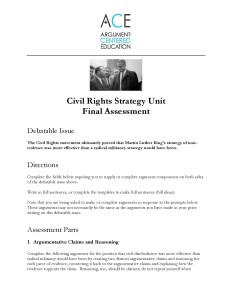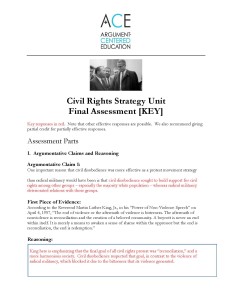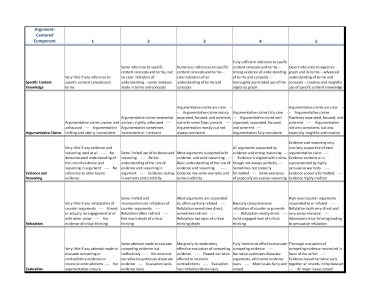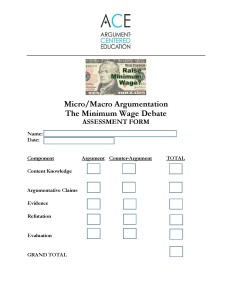
Two New Argument-Based Assessment Samples
Many schools have recently completed their semester-ending final exams. Teachers I was working with yesterday, for instance, told me that they were done with 85% of their essay grading from finals. They reported feeling both a kind of relief that they could see the light at the end of the tunnel, and a surge of motivation to finish, get their grades in, and feel that sense of accomplishment at having fully completed the semester.
This focus on the end of the semester got us thinking about posting on a couple of recent examples of argument-based assessments that we at Argument-Centered Education have developed with our school partners this year. What follows are two samples of assessment tools that have been used recently in our partners’ argument-centered classrooms. These tools can be used or adapted as is – they have been implemented successfully and are ready for wider use – but they can also be taken as models of the ways that argument-based instruction can connect to, generate, and be back-designed from argument-based assessments.
An Argument-Based Exam on Civil Rights Strategy
Regular (and maybe some occasional) readers of The Debatifier will recall our recent post on an Argumentative Claim Creator Activity that we designed with humanities teachers at multiple schools on a debatable issue on the Civil Rights movement – namely, whether civil disobedience was a more effective strategy for the movement than radical militancy would have been. The activity puts in front of students an evidence set culled from the unit’s media list and primary documents (the subject of a separate set of DBQ-type questions, distinguished by their argument focus) and asks them to create argumentative claims located between the generality of an overall position on the debatable issue, and the detail of textual evidence. One of the objectives of the activity is to significantly increase students’ understanding of the relationship between an argument and a position; we want students to come to see arguments as evidenced, focused, separate reasons for their position.
Students at one of our partner schools struggled some with their assimilation of this fundamental conception of argumentative claims and their positional relation to an overall position (above them) and evidence and reasoning (below them). It was more or less the first time these students created argumentative claims in an academic context like this, so we weren’t at all surprised. To help ensure that they were being properly supported in their growth on these key academic skills, what we did was build an argument-based assessment instrument, one more formative than summative, though it was fully integrated into lesson planning and it did count toward students’ grading.
 This assessment instrument has three sections. The first asks students to complete argumentative claim stems based on supplied evidence from the civil rights strategy set of evidence to be found in the Argumentative Claim Creator Activity. Students also have to then formulate reasoning to analyze the evidence’s support for the claim that they previously completed. The second section asks students to read a piece of text, craft a counter-argument from it to a stipulated position on the same debatable issue (civil rights strategy), and then (drawing on another passage) to refute the counter-argument. And the third and final section supplies four claims that students have to (a) match evidence to, from an evidence sub-set; and (b) formulate reasoning that analyzes how their matched evidence supports or proves the claim.
This assessment instrument has three sections. The first asks students to complete argumentative claim stems based on supplied evidence from the civil rights strategy set of evidence to be found in the Argumentative Claim Creator Activity. Students also have to then formulate reasoning to analyze the evidence’s support for the claim that they previously completed. The second section asks students to read a piece of text, craft a counter-argument from it to a stipulated position on the same debatable issue (civil rights strategy), and then (drawing on another passage) to refute the counter-argument. And the third and final section supplies four claims that students have to (a) match evidence to, from an evidence sub-set; and (b) formulate reasoning that analyzes how their matched evidence supports or proves the claim.
ACE designed an assessment key that provides idealized responses to each argument-based short-writing requirement in the assessment. Student responses were on a sliding scale toward and away from the models in the key, and teachers have of course provided partial credit for partial mastery over the skills and content understanding implicated in each section of the exam, with commensurate feedback.
 ACE partner teachers believed that this assessment was a preferable way to culminate the civil rights strategy unit to a structured argumentation activity, in-class debate, or argument essay, since it isolates steps and processes in the successful execution of academic argumentation, whereas those other ways of culminating an argument-based unit bring together all of the steps and processes and amalgamate them in complex, interconnected projects that, when students are less successful, tend to obscure rather than expose what it is students do not yet understand about academic argumentation.
ACE partner teachers believed that this assessment was a preferable way to culminate the civil rights strategy unit to a structured argumentation activity, in-class debate, or argument essay, since it isolates steps and processes in the successful execution of academic argumentation, whereas those other ways of culminating an argument-based unit bring together all of the steps and processes and amalgamate them in complex, interconnected projects that, when students are less successful, tend to obscure rather than expose what it is students do not yet understand about academic argumentation.
Micro/Macro Debates Assessment Form
Another Argument-Centered Education partner has recently been using another one of our formats adapted for a personal finance classroom: Micro/Macro Debates on whether the federal minimum wage should be raised to $15/hour.
In this format, the class is divided in half, with one side favoring this increase in the minimum wage, the other opposing it. On each side, students are divided into four teams of (about) three; each team on the pro-increase side is given one of the following argumentative claims to find evidence to support, to fill out this argument for its position.
- Raising the minimum wage would increase economic growth by increasing the spending capacity of lower-income workers.
- It is economically unjust and immoral for lower-income workers to be paid so little when upper-income workers are paid so much.
- The minimum wage is at historically low levels, so precedent justifies an increase in the minimum wage.
- Increasing the minimum wage would increase worker productivity, helping businesses.
The anti-increase side teams of three (or so) are assigned one of these argumentative claims developing their position:
- Increasing the minimum wage will result in increased unemployment since businesses won’t be able to afford to hire as many workers.
- Inflation results from artificial wage hikes, and inflation is bad for the economy and bad for workers.
- Minimum wage workers are mainly not primary “bread-winners” so increasing it won’t reduce poverty.
- Governmental intrusion in the free market is unnecessary and counter-productive.
Also, each team is assigned one argumentative claim from the other side’s list (i.e., the claims supporting the opponents’ position) to construct counter-arguments against.
Then, in the Micro-Debates portion of the project, the instructor alternates between the argumentative claims, calling up each team that was assigned to research and build either the argument or counter-arguments. They conduct a micro-debate in about 4 minutes on that one argumentative claim. These are called ‘micro-debate rounds,’ and there are 8 of them, before the macro-debate segment takes place. In the macro-debate, the instructor moderates a 10 minute open discussion during which students attempt to put synthesize and evaluate the arguments made throughout the micro-debates in a way that ultimately favors their position over the other side’s position.
The instructors involved in this argument-based project requested an assessment form for each student’s preparation for and participation in the Micro/Macro Debates. We adapted our universal debate performance rubric for this purpose and created a specific assessment form. The form assesses student argumentative performance in both the argument and counter-argument participation in the micro-debates. Performance in the macro-debate is purely bonus and additive to a student’s micro-debate ratings.
This assessment rubric is usable in its current form across a wide range of classroom argumentation and debate activities. The assessment form is readily revised and adaptable to argument-based activities and projects . . . perhaps yours!



